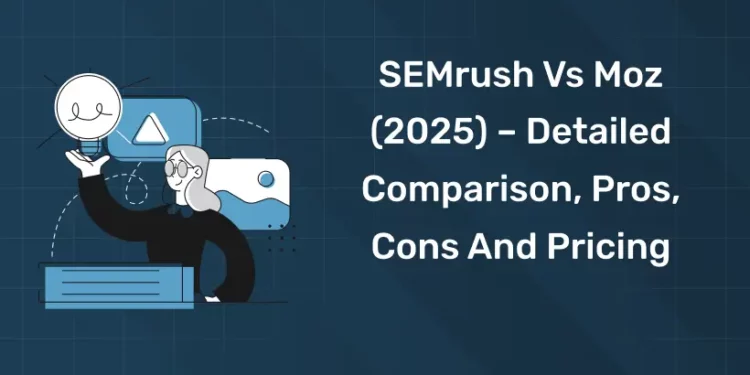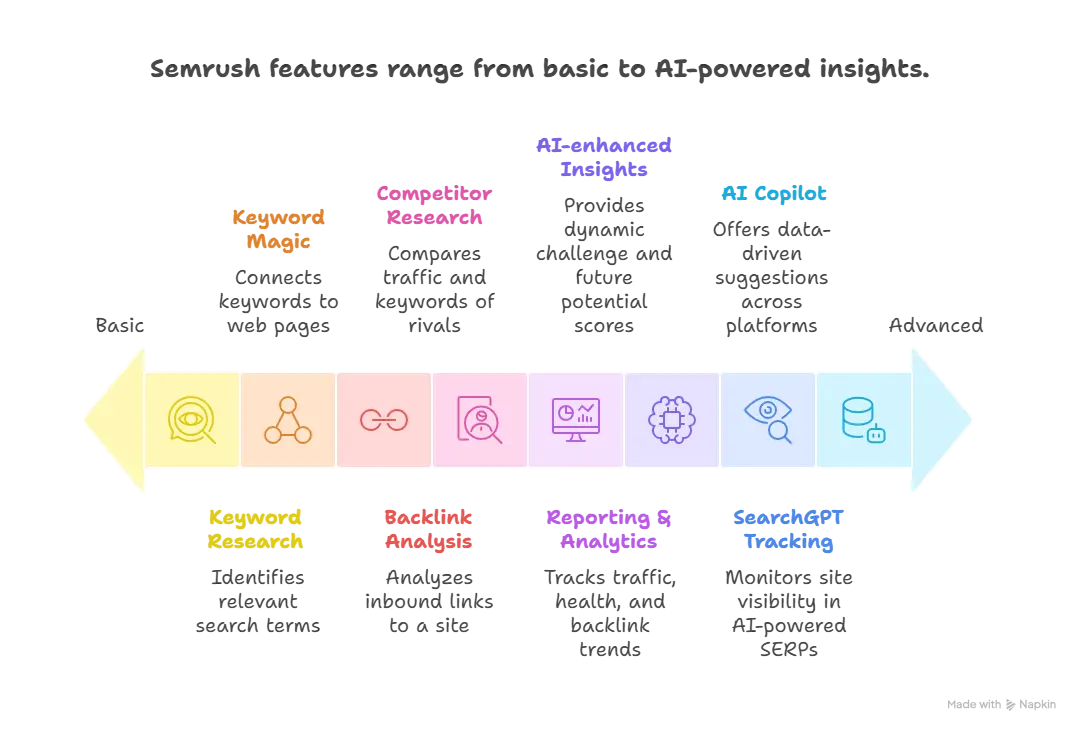Table of Contents
SEO is one of the hardest things for companies, bloggers, and marketers to do in today’s fast-paced digital environment. Having the appropriate SEO tool may make or break your online exposure since algorithms are always changing, competition is becoming tougher, and you need to rank higher. There are a lot of choices, but two names come up a lot: SEMrush and Moz. Professionals all around the globe trust both for keyword research, site audits, and competition analysis, but it’s not always simple to choose the best one. If you make the incorrect choice, you might lose time and money, get bad information, and develop more slowly. We made this in-depth comparison of SEMrush vs Moz for 2025 to help you choose the tool that works best for your SEO strategy. It includes information on features, benefits, downsides, cost, and real-world use scenarios.
Discover the power of performance marketing! Join Free Demo Course Here!
Overview of SEMrush and Moz
Here’s a side-by-side look at SEMrush and Moz, with some important numbers and background information to get things started for a more in-depth comparison.
SEMrush
Oleg Shchegolev and Dmitri Melnikov started SEMrush (now called “Semrush”) in 2008 as an SEO tool that grew out of a previous extension.
Over the years, it has expanded from a modest set of tools into a complete digital marketing suite with more than 50 modules for SEO, content, PPC, social media, and competitive intelligence.
Semrush has the following as of 2025:
- More than 117,000 clients who pay.
- More than 1,600 people work in offices throughout the world.
- A database of keywords with more than 26 billion entries (in databases from 121+ countries).
Semrush calls itself a “all-in-one” marketing intelligence tool that gives you information on organic, paid, content, and competitive areas.
Moz
Rand Fishkin and Gillian Muessig started Moz in 2004 as SEOmoz. In 2012, the company changed its name to Moz.
Moz changed from being a consultancy and blogging community to a SaaS tool supplier that focuses on SEO and inbound marketing.
Here are some more things you should know about Moz:
- Seattle, Washington is where the headquarters are.
- Number of employees: around 353 (as of the most current profile)
- A lot of marketers, agencies, and companies utilize Moz Pro and other comparable solutions to get work done.
- Moz is famous in the SEO world for its Link Explorer index and measures like Domain Authority (DA).
Moz doesn’t always provide as many “user count” numbers as Semrush, but its brand and community are still powerful in the SEO field.
SEMrush Features & Benefits
1: What is the primary goal of SEO (Search Engine Optimization)?
One of the most complete SEO and marketing tools on the market is still SEMrush, which is now just called “Semrush.” It keeps getting better with AI, more data, and more connections. Here is a list of its main features and what makes them appealing:
Keyword Research
- Keyword Summary and Difficulty Check the number of searches, the trend lines, the difficulty of the keywords, the SERP features, and the different types of keywords.
- Keyword Magic/Strategy Builder: Start with a topic and grow it into groups of keywords that are thematically linked. This tool helps you connect keywords to web pages.
- AI-enhanced insights: Starting in 2025, Semrush will add AI to its keyword tools, which will give you dynamic challenges that are specific to your area, future potential scores, and semantic topic ideas.
- SearchGPT / AI Mode Tracking: This is an advanced feature that lets you check or keep an eye on how your site shows up in SERPs that are powered by AI, not just Google.
Analysis of Backlinks
- You can see the full inbound profile for any site, including sending domains, anchor texts, new and lost links, and reputation measures, with Backlink Analytics & Audit.
- When you look at your backlink profile next to that of your rivals, you can find link chances that they have but you don’t.
- Tools for tracking and disavowing harmful links: Mark links that could be dangerous and export reject entries.
- Views based on filters and dates: You can narrow your search by name type (like “dofollow” or “nofollow”), location, and time frame.
Competitor Research
- Domain Overview/Organic Research: See a quick look at the traffic, keywords, and content trends of any rival.
- Traffic and Market Tools: Semrush now has tools that let you figure out where your competitors’ traffic is coming from, how it’s getting there, and how it’s changing over time. Plus 2Semrush Plus 2
- Keyword Gap/Content Gap: Find terms that your rival ranks for but you don’t, or the other way around. Thanks for your message.
- Information about ads and pay-per-click (PPC) campaigns: Because Semrush covers both SEO and SEM, you can look at their paid campaigns, ad text, and budget estimates.
Reporting & Analytics
- You can make your own screen with key measures like organic traffic, site health, and backlink trends, and it can connect to Google Analytics or GSC.
- Automated, branded reports: Make PDF reports that mix different parts (SEO, content, and social) and send them to stakeholders on a set plan.
- Trends and alerts: Watch for changes in ranking, exposure, or strange events through alerts so you don’t miss rapid drops.
- Toolkits and integrated workflows: In 2025, Semrush launched a structure called “Toolkits,” which is AI-powered and flexible, to make reporting and cross-tool processes easier.
Unique Features
- Copilot driven by AI and insights: Semrush Copilot is like having a helper built right in. It looks at data from different parts and shows you the best ideas.
- SearchGPT/AI Mode tracking: One way to set your product apart from the competition is to track topic exposure in AI/generative interfaces as well as basic search.
- Holistic “Toolkits” architecture: Semrush’s younger user interface groups its tools into sensible groups (SEO, content, market, etc.), which makes it easier to find your way around.
- Large, up-to-date databases: Semrush changes its search often and says it has strong site coverage and new traffic details.
- SEO, PPC, content, and social media all in one suite: A lot of tools are good at one thing, but Semrush is good at giving you insight across all channels in one place.
Become an AI-powered Digital Marketing Expert
Master AI-Driven Digital Marketing: Learn Core Skills and Tools to Lead the Industry!
Explore CourseMoz Features & Benefits
Moz (especially Moz Pro) is still a popular and easy-to-use SEO tool, especially for small to medium-sized websites and marketers who want clear, reliable data and simple tools. Here is a list of Moz’s most important features and what makes it unique.
Keyword Explorer
It lets you enter keywords (or domains) and gives you back information like monthly volume, expected difficulty, organic click-through rate (CTR), and priority score, which is a mix of data that helps you choose which terms to target.
- It suggests keywords based on similar terms, broad matches, question-based sentences, and more.
- Localization is supported; you can sort search data by country or area to see what works in different markets.
Site Audit and Crawl
Moz has a site crawl and analysis tool that looks for technical SEO problems like missing or broken meta tags, duplicate content, mistakes that make the site hard to crawl, and so on.
- Problems are ranked and labeled (for example, “critical” and “warning”) to help with fixes.
- Instead of waiting for planned walks, you can do them “on demand.” This is helpful when you want to get new feedback after releasing fixes.
Adding links or looking at links
Moz’s newer “Open Site Explorer” and “Link Explorer” let you look at a domain’s backlink profile, including the number of linking root sites, the spam score, the anchor text distribution, and the number of new and lost links.
- Moz says that Link Explorer is based on a huge link index with tens of trillions of links.
- It suggests link opportunities by comparing your link profile to that of your rivals, finding sites that link to content that is similar to yours, and so on.
- The Spam Score measure helps find related sites that might be damaging or of low quality.
Rank Tracking
-
Moz lets you track keywords’ positions over time, across different locales.
-
You can see SERP features (featured snippets, local packs, etc.) and how your pages rank relative to them.
-
History/trend tracking enables you to monitor whether your optimization efforts are having an effect.
Reporting Features
-
Moz provides automated, branded reports (PDF, CSV) combining keyword, link, crawl, and ranking data.
-
Reports can be scheduled (e.g., monthly) and delivered to stakeholders.
-
Dashboard / Analytics UI gives a high-level snapshot of domain authority, link trends, crawl health, keyword performance, and competitor benchmarks.
-
The dashboard is designed with simplicity in mind—reducing clutter and making insights more digestible for users who don’t want to wade deep into data.
Unique/Differentiating Features
- The Domain Authority (DA) and Page Authority (PA) measures were made popular by Moz, and many people in SEO still use them. For measuring sites, they are generally used as proxies.
- Simplicity and an easy-to-use interface: Compared to more complicated systems, Moz is easier for many users to learn.
- Strong teaching material and community: Moz’s blog, tips, and “Whiteboard Friday” have long been known as a trusted place to learn about SEO and get help from other people in the community.
- The MozBar browser plugin or SERP overlay is a useful and lightweight tool that displays on-page metrics, DA/PA, and link metrics right in search results or on any page.
- Moz Local offers tools to help companies with a local presence handle their business listings, keep an eye on reviews, and make sure their NAP (Name, Address, Phone) stays the same across all sites.
SEMrush vs Moz Pricing
Pricing is a big part of making decisions. As of 2025, here is a list of what each of their plans includes. Always check their official websites twice to make sure you’re seeing the most recent changes or deals.
Pricing Table
| Plan / Tier | SEMrush Price* | Key Limits & Features | Moz Price* | Key Limits & Features |
|---|---|---|---|---|
| Entry / Basic | Pro: $139.95/mo (or ~$117.33/mo if billed annually) | ~5 projects, 500 keyword tracking, 10,000 results per report | Starter: $49/mo | 50 tracked keywords, 1 campaign, essential tools (crawl, rank, link) |
| Mid / Growth | Guru: $249.95/mo (or ~$208.33/mo annually) | ~15 projects, 1,500 keyword tracking, historical data, content tools, Looker Studio integration | Standard / Medium: $99/mo (or ~$79/mo annually) | ~300 tracked keywords, 3 campaigns, backlink analysis, unlimited reports |
| Higher / Agency | Business: $499.95/mo (or ~$416.66/mo annually) | ~40 projects, 5,000 keywords, API access, extended limits | Large / Premium: $299/mo, $599/mo (Premium) | 3,000 keyword tracking, more users, more campaigns, priority support, historical data etc. |
Side-by-Side Comparison
Discount for One Year vs. One Month
- It saves you about 17% if you pay for SEMrush all at once. For example, Pro costs about $117.33 a month instead of $139.95.
- Moz also often offers savings for paying yearly (TechRadar lists a discount of about 20%).
Different Features and Limits
- When it comes to projects, results, and data access, SEMrush tends to set stricter limits at the same “tier,” especially for its more expensive plans.
- Moz is better because it has easier, flexible tiers and often more roomy seats for users in medium or large plans that don’t cost a lot extra.
- There are toolkits for SEMrush, such as SEO, Content, Social, and more. These paid features sometimes cost extra.
- Different plans of SEMrush charge different amounts for extra users: $45 (Pro), $80 (Guru), or $100 (Business).
Trials for free and trial periods
- Plans like Pro and Guru come with a 7-day free sample that can be stretched to 14 days during promotions.
- Moz Pro (Standard and Medium plans) comes with a 7-day free trial so users can see what it can do before buying it.
SEMrush vs Moz Pros and Cons
When it comes to platforms that provide extensive and high-quality search engine optimization abilities, Moz and SEMrush are two options that are both worth considering. It may be challenging to decide which one to choose. Moz differentiates out from the competition because of its user-friendly interface, trustworthy measurements of authority, and layout that is easy for beginners to use. These features are in stark contrast to SEMrush, which has a complex analytics system, a full marketing suite, and a vast database. For the sake of maintaining clarity, I have included a summary of the pros and downsides of each instrument in the following section.
SEMrush—Pros & Cons
Pros
- More reports, keyword searches, and project capacity than many of its rivals, which is a big plus
- A very big keyword database and backlink index (which helps you find more chances)
- A wide range of features: SEO, content, PPC, social media, and analytics all in one place
- Advanced information (such tailored difficulty and AI modes) and advanced tools for competitors
- Good reporting, dashboards, and ways to see data
Cons
- High expense, particularly for small enterprises or those who work for themselves; a learning curve; and a UI that could be too much for beginning users.
- Some circumstances have limited “free” help or delayed response times from people.
- Some important features, datasets, or API access are only available to higher-tier subscriptions.
- During busy periods, it may take longer to make reports or run big queries.
Moz—Pros & Cons
Pros
- Lower starting price than many of its rivals
- Easier to understand and use, which is great for beginners and small teams.
- Link Explorer is a great tool for finding backlinks, and Spam Score and Domain Authority are important link metrics.
- Features for on-demand crawls and audits, as well as configurable rank tracking
- DA/PA are well-known indicators that the SEO industry trusts.
- Good reporting tools and features for keeping an eye on site health
Cons
- Compared to the best rivals, this one has a smaller keyword database and fewer keyword recommendations.
- Tighter rules on how and when to report (particularly at lower ranks)
- In many situations, there are no traffic figures for domains, which makes it hard to compare competitors.
- Some features, such as finding broken links or global volumes, are absent or not as strong.
- Not as proactive in rolling out new features or innovations as some rivals
Become an AI-powered Digital Marketing Expert
Master AI-Driven Digital Marketing: Learn Core Skills and Tools to Lead the Industry!
Explore CourseUse Case Comparison
When choosing between SEMrush and Moz, you should consider who you are and what your SEO objectives are. Each tool works well in certain situations:
SEO for Small Business
- Moz is generally a better choice for small companies since it has a simpler layout, reduced prices, and keyword tools that are easy for beginners to use.
- It helps company owners stay on top of important tasks like local SEO, keyword monitoring, and link development without making them feel overwhelmed.
SEO for Agencies
- For agencies that work with more than one customer, SEMrush is the obvious winner.
- Its comprehensive reporting, competition research, and multi-project management tools let agencies provide precise information and keep track of progress on many campaigns at once.
Blogging and Content Marketing
- SEMrush has tools for bloggers and content producers that help them do more in-depth keyword research, find gaps in their material, and explore new topics.
- Moz is still a decent option if you want simple keyword difficulty ratings and a short learning curve, however.
Enterprise SEO
- SEMrush is the best choice for businesses since it has huge databases of keywords and backlinks, as well as integrations and the opportunity to grow.
- It helps big groups with complicated SEO, PPC, and content processes. Moz is reputable, but for big businesses, it could not have enough data or be big enough.
Discover the power of performance marketing! Join Free Demo Course Here!
SEMrush vs Moz Accuracy & Reliability
When comparing SEO tools, accuracy and reliability matter as much as features. Below are key dimensions to consider — and how SEMrush and Moz perform—illustrated with real-world observations.
Keyword Database Size
- SEMrush now has 142 geographic datasets with 26.7 billion+ keywords that span more than 808 million websites.
- This huge size allows SEMrush a wider range of terms to use when looking for long-tail, local, or specialty keywords.
- Moz, on the other hand, doesn’t openly brag about having as many keywords. Moz’s success lies more in its ability to filter out irrelevant keywords and concentrate on the right ones than in its size.
- Some SEO users say that Moz’s keyword results occasionally leave out less frequent search keywords that SEMrush’s index has, particularly in places that aren’t in the US or are quite specific.
Backlink Index & Quality
- SEMrush says it has a database of 43 trillion+ backlinks from hundreds of millions of referring sites.
- That covers both old link data and new (recently scanned) connections, making it one of the biggest commercial backlink indexes in SEO tools.
- People trust and like Moz’s Link Explorer, although other reviews say that it “doesn’t show all the websites linking to yours” or that it may not be as up-to-date as its rivals.
- Moz’s edge comes from its more precise measures, such as Spam Score, Domain Authority/Page Authority, and a better curated link index that focuses on important connections.
Update Frequency & Freshness
- SEMrush continually upgrades its databases and data pipelines. It looks at the top 100 organic results for each term in its US database to maintain its domain/keyword analytics up to date.
- It’s monitoring its location, and some publications provide daily updates while it’s in tracking mode.
- Moz also crawls and updates, but how often and how fresh they are depends on the plan level and how Moz ranks sites.
- According to user reviews, Moz’s backlink data often lags behind that of other top tools when it comes to finding new connections.
Real-World Test Examples & Comparisons
- SEMrush upgrades its databases and data pipelines on a regular basis. To keep its domain/keyword analytics up-to-date, it looks at the top 100 organic results for each term in its US database.
- When in tracking mode, it shows daily updates on particular reports.
- Moz also does crawls and updates, but how often and how fresh they are depends on the plan level and how Moz ranks sites.
- Some users have stated that Moz’s backlink data doesn’t always keep up with the newest links as well as other top tools.
Verdict: Which One Should You Choose?
SEMrush and Moz are both great SEO tools, but which one is best for you depends on what you require.
- For those who are just starting out or have small companies- Moz is easier to use, less expensive, and has all the basic SEO capabilities without becoming too complicated.
- For agencies and professional SEOs – SEMrush has more in-depth information, bigger databases, and better reporting, which makes it great for managing many customers.
- For bloggers and content producers – SEMrush offers better keyword research, content gap analysis, and subject ideas to help you get more visitors to your site quickly.
- For businesses – SEMrush works better with APIs, integrations, and analytics that are at the enterprise level.
The best way to choose is to try them out yourself. If you require more complex data and the opportunity to grow, consider SEMrush’s free trial. If you prefer a simpler, more beginner-friendly experience, try Moz’s free trial.
Conclusion
In 2025, the choice between SEMrush and Moz will rely on your objectives, money, and degree of SEO knowledge. SEMrush is great for agencies and businesses since it has a huge database, comprehensive analytics, and the flexibility to grow. Moz, on the other hand, is easy to use, has reliable authority indicators, and is cheap, making it great for small companies and those just starting out. You can improve your SEO with either tool, but the best way to find out is to try them both.
Frequently Asked Questions
How much does SEMrush cost?
SEMrush pricing starts at around $129.95/month for the Pro plan, with higher tiers (Guru and Business) offering expanded limits, historical data, and advanced reporting. A free trial is available to test the platform before subscribing.
Can Moz replace SEMrush?
Moz can replace SEMrush for basic SEO tasks like keyword tracking, site audits, and link building, especially if you’re a beginner or a small business. However, SEMrush offers a broader toolkit with PPC, social, and content marketing features that Moz does not fully match.
Is SEMrush better for keyword research than Moz?
Yes, SEMrush generally provides a larger keyword database, more variations, and fresher data compared to Moz. This makes it stronger for in-depth keyword research and competitor analysis. Moz still offers reliable keyword difficulty scores but has a smaller dataset.
Which is best for beginners?
Moz is often recommended for beginners due to its simpler interface, affordable pricing, and straightforward SEO tools. SEMrush, while more powerful, has a steeper learning curve and is better suited for agencies, advanced users, or enterprises.













